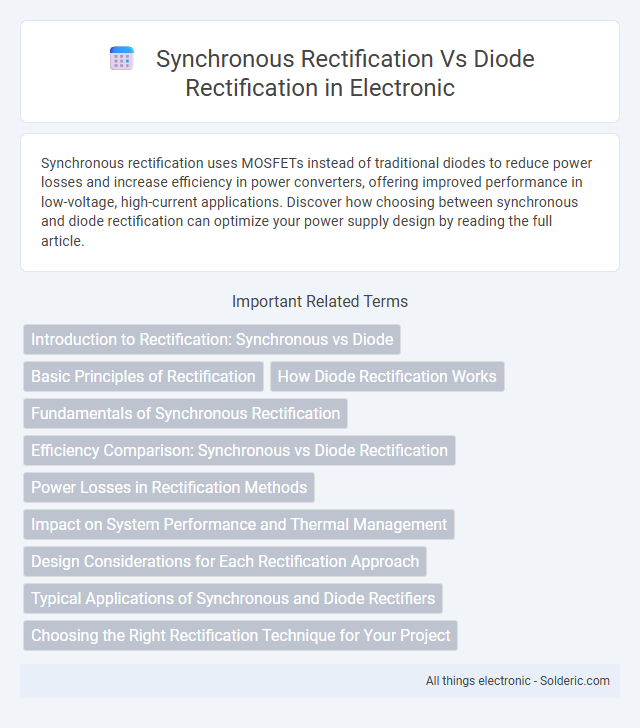Synchronous rectification uses MOSFETs instead of traditional diodes to reduce power losses and increase efficiency in power converters, offering improved performance in low-voltage, high-current applications. Discover how choosing between synchronous and diode rectification can optimize your power supply design by reading the full article.
Comparison Table
| Feature | Synchronous Rectification | Diode Rectification |
|---|---|---|
| Technology | Uses MOSFETs as controlled switches | Uses semiconductor diodes for conduction |
| Efficiency | High efficiency (up to 95%+) | Lower efficiency due to diode forward voltage drop |
| Power Loss | Reduced conduction losses | Significant conduction losses in forward-biased diodes |
| Heat Generation | Lower heat dissipation | Higher heat generation, requires better cooling |
| Complexity | More complex control circuitry required | Simple design, no external control needed |
| Cost | Higher initial cost due to control logic and components | Lower cost and easier implementation |
| Applications | High-performance DC-DC converters, switching power supplies | Basic rectification tasks, low-cost power supplies |
| Switching Frequency | Suitable for high-frequency switching | Limited frequency operation due to diode recovery time |
Introduction to Rectification: Synchronous vs Diode
Synchronous rectification uses MOSFETs controlled by a timing circuit to replace diodes, significantly reducing power loss and improving efficiency in DC-DC converters. Diode rectification relies on semiconductor diodes that inherently suffer from a forward voltage drop, causing increased heat generation and decreased energy efficiency. Your choice between synchronous and diode rectification impacts overall power conversion performance, especially in low-voltage, high-current applications.
Basic Principles of Rectification
Synchronous rectification uses MOSFETs controlled by a timing circuit to replace diodes, significantly reducing voltage drop and improving efficiency in power conversion. In contrast, diode rectification relies on semiconductor diodes that inherently have a fixed forward voltage drop, typically around 0.7V for silicon diodes, leading to greater power loss. The synchronous approach actively switches devices in sync with the AC waveform, while diode rectification passively conducts current only during forward bias.
How Diode Rectification Works
Diode rectification works by allowing current to flow only in one direction through semiconductor diodes, converting alternating current (AC) into pulsating direct current (DC). Each diode in a bridge rectifier conducts during alternate half-cycles of the AC input, ensuring unidirectional current flow and producing a full-wave rectified output. This method is simple, reliable, and cost-effective but typically results in higher power losses due to the diode's forward voltage drop, usually around 0.7 volts for silicon diodes.
Fundamentals of Synchronous Rectification
Synchronous rectification utilizes MOSFETs instead of diodes to reduce conduction losses and improve efficiency in power conversion circuits. Unlike diode rectification, which relies on the inherent voltage drop of diodes (typically 0.7V for silicon diodes), synchronous rectifiers minimize power loss by actively switching transistors that have much lower on-resistance. Understanding the fundamentals of synchronous rectification enables you to optimize power supplies and DC-DC converters for better thermal performance and higher overall efficiency.
Efficiency Comparison: Synchronous vs Diode Rectification
Synchronous rectification offers significantly higher efficiency than diode rectification due to reduced conduction losses by replacing diodes with low-resistance MOSFETs, especially in low-voltage, high-current applications. Diode rectifiers suffer from forward voltage drops typically around 0.7V for silicon diodes, leading to greater power dissipation and heat generation. This efficiency improvement in synchronous rectifiers can exceed 10%, making them ideal for power supplies and DC-DC converters where energy conservation and thermal management are critical.
Power Losses in Rectification Methods
Synchronous rectification significantly reduces power losses compared to diode rectification by replacing diodes with low-resistance MOSFETs, leading to lower conduction losses. Diode rectification incurs higher power dissipation due to the inherent forward voltage drop of silicon diodes, typically around 0.7 volts, which increases heat generation and decreases efficiency. In high-current applications, synchronous rectification can improve efficiency by up to 95% or more, making it the preferred choice for power-sensitive designs.
Impact on System Performance and Thermal Management
Synchronous rectification significantly improves system performance by reducing conduction losses compared to diode rectification, resulting in higher efficiency and lower voltage drops. This efficiency gain leads to reduced heat generation, enhancing thermal management and potentially allowing for smaller heat sinks or less active cooling. Diode rectifiers, while simpler, produce higher power dissipation and require more robust thermal solutions to maintain reliability and prevent thermal runaway.
Design Considerations for Each Rectification Approach
Synchronous rectification requires careful selection of low-resistance MOSFETs and precise gate drive timing to minimize conduction losses and improve efficiency in power converters. Diode rectification relies on choosing diodes with low forward voltage drop and fast recovery times, balancing cost-effectiveness against higher power dissipation and heat generation. Thermal management and switching frequency are critical design factors influencing the choice between synchronous and diode rectification in applications such as DC-DC converters and power supplies.
Typical Applications of Synchronous and Diode Rectifiers
Synchronous rectifiers are predominantly used in high-efficiency power supplies, such as computer motherboards, electric vehicles, and renewable energy systems where minimizing conduction losses is critical. Diode rectifiers remain common in low-cost, low-frequency applications like basic AC/DC adapters, battery chargers, and power supplies where efficiency demands are lower and simplicity is preferred. Industries leverage synchronous rectification in advanced DC-DC converters and telecommunications equipment to optimize energy savings, while diode rectification suits cost-sensitive consumer electronics and industrial machinery.
Choosing the Right Rectification Technique for Your Project
Choosing the right rectification technique depends on efficiency, cost, and application requirements. Synchronous rectification offers higher efficiency by reducing voltage drop and power loss compared to diode rectification, making it ideal for low-voltage, high-current designs. Your project benefits from synchronous rectification when minimizing heat dissipation and maximizing power savings are priorities, whereas diode rectification suits simpler, cost-sensitive applications.
synchronous rectification vs diode rectification Infographic

 solderic.com
solderic.com